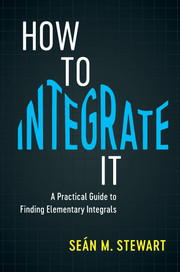Book contents
- Frontmatter
- Contents
- Preface
- 1 The Riemann Integral
- 2 Basic Properties of the Definite Integral: Part I
- 3 Some Basic Standard Forms
- 4 Basic Properties of the Definite Integral: Part II
- 5 Standard Forms
- 6 Integration by Substitution
- 7 Integration by Parts
- 8 Trigonometric Integrals
- 9 Hyperbolic Integrals
- 10 Trigonometric and Hyperbolic Substitutions
- 11 Integrating Rational Functions by Partial Fraction Decomposition
- 12 Six Useful Integrals
- 13 Inverse Hyperbolic Functions and Integrals Leading to Them
- 14 Tangent Half-Angle Substitution
- 15 Further Trigonometric Integrals
- 16 Further Properties for Definite Integrals
- 17 Integrating Inverse Functions
- 18 Reduction Formulae
- 19 Some Other Special Techniques and Substitutions
- 20 Improper Integrals
- 21 Two Important Improper Integrals
- Appendix A Partial Fractions
- Appendix B Answers to Selected Exercises
- Index
21 - Two Important Improper Integrals
Published online by Cambridge University Press: 11 December 2017
- Frontmatter
- Contents
- Preface
- 1 The Riemann Integral
- 2 Basic Properties of the Definite Integral: Part I
- 3 Some Basic Standard Forms
- 4 Basic Properties of the Definite Integral: Part II
- 5 Standard Forms
- 6 Integration by Substitution
- 7 Integration by Parts
- 8 Trigonometric Integrals
- 9 Hyperbolic Integrals
- 10 Trigonometric and Hyperbolic Substitutions
- 11 Integrating Rational Functions by Partial Fraction Decomposition
- 12 Six Useful Integrals
- 13 Inverse Hyperbolic Functions and Integrals Leading to Them
- 14 Tangent Half-Angle Substitution
- 15 Further Trigonometric Integrals
- 16 Further Properties for Definite Integrals
- 17 Integrating Inverse Functions
- 18 Reduction Formulae
- 19 Some Other Special Techniques and Substitutions
- 20 Improper Integrals
- 21 Two Important Improper Integrals
- Appendix A Partial Fractions
- Appendix B Answers to Selected Exercises
- Index
Summary
‘Do you know what a mathematician is?’, Lord Kelvin once asked a class. He stepped to the blackboard and wrote Putting his finger on what he had written, he turned to the class. ‘A mathematician is one to whom that is as obvious as that twice two makes four is to you.’
— Lord KelvinIn this our final chapter we present evaluations for two important improper integrals that arise in applications. Each evaluation is made using elementary means based on ideas at a level not beyond those encountered and used throughout this text. The two improper integrals to be considered are
which are known as the the Gaussian integral and the Dirichlet integral, respectively. What makes the evaluation of these integrals particularly troublesome is that in neither case do the corresponding indefinite integrals admit expressions in elementary terms. By a remarkable stroke of luck, values in terms of known mathematical constants can, however, be found for each of these two improper integrals.
The Gaussian Integral
We start by showing the Gaussian integral converges. We write it as For the first of the integrals on the right, as e-x2 is continuous for all x [0; 1] the integral exists and is Riemann integrable. For the second integral appearing on the right, as x2 > x for x > 1, multiplying both sides of the inequality by negative one and exponentiating, as the exponential function is monotonic, the inequality is equivalent to e-x2 < e-x for all x > 1. Since
converges, by the direct comparison test d x also converges, thereby showing that the Gaussian integral converges.
In evaluating the Gaussian integral the tools to be used are reduction formulae, two inequalities, and the squeeze theorem for limits. While the approach to be used is quite involved, importantly it does not rely on techniques beyond the scope of this text. Let
where n N. In the first of these integrals, if we let x sin θ; d x = cosθ dθ while for the limits of integration, when x = 0; θ = 0 and when.
- Type
- Chapter
- Information
- How to Integrate ItA Practical Guide to Finding Elementary Integrals, pp. 298 - 312Publisher: Cambridge University PressPrint publication year: 2017



